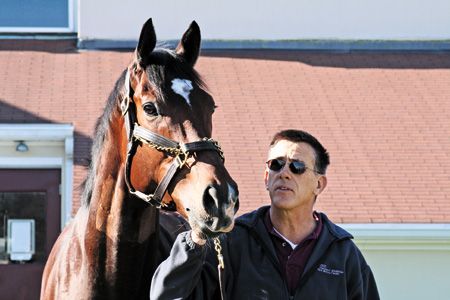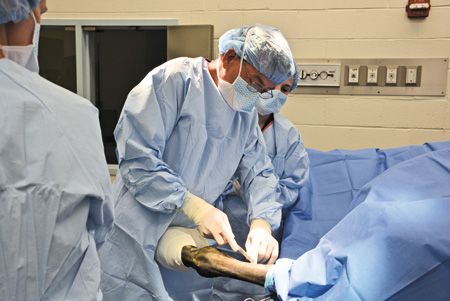A life of unbridled innovation
Dr. Dean Richardson looks back at a veterinary career continuously on the leading edge of equine orthopedic surgery.

Fighting for recovery. Dr. Dean Richardson cared for 2007 Kentucky Derby winner and Triple Crown hopeful Barbaro at Penn Vet's New Bolton Center after the horse shattered his right hindlimb at the Preakness Stakes. Barbaro was eventually euthanized due to laminitis. (Photos courtesy of UPenn School of Veterinary Medicine New Bolton Center)Dean Richardson, DVM, DACVS, has certainly made an impact on equine orthopedics. The award-winning chief of large animal surgery at the University of Pennsylvania's New Bolton Center has worked on some of the world's most famous horses and continues to train and inspire the next generation of veterinary surgeons.
“I am unbelievably lucky to have a career that I've been happy doing. I really don't have any hesitation saying I jump up to go to work, and I love my job,” says Richardson, the Charles W. Raker Professor of Equine Surgery at the University of Pennsylvania's School of Veterinary Medicine. “I've tried to innovate in equine surgery by trying new techniques and exploring new ideas to make the repairs more sophisticated and less traumatic.”
Getting ‘hooked on horses'
Growing up in Honolulu, the son of a U.S. Navy captain and physician, Richardson knew nothing about horses. At the age of 16, as a freshman at Dartmouth College, Richardson chose at random a course on horseback riding to fulfill a physical education requirement. Despite his lack of experience, Richardson says he got hooked on horses and started taking horsemanship more seriously.
Showing horses, Richardson earned his “A” pony club certificate by his junior year. He started three-day eventing (also known as combined training) and began working at Huntington Farm, a well-known eventing farm in South Strafford, Vermont. Still in operation today, Huntington Farm has changed ownership but is still known for its three-day eventing and dressage school, as well as horse breeding. As time passed, “I continued to get more serious about working with horses,” remembers Richardson.
As a drama major at Dartmouth, he initially had ambitions of going into theater. However, the more he worked at it, the more he realized drama was not his calling (“a serious lack of talent,” as he recalls). Instead, he took science courses to pursue a career in equine veterinary medicine.
After completing his bachelor's degree at Dartmouth, Richardson took a year off and went to North Carolina to work for Fred B. McCashin, VMD, now the owner of Carolina Equine Clinic in Southern Pines, North Carolina. McCashin had qualified to ride on the U.S. Equestrian Team in 1961. However, he chose veterinary school, earning his VMD from the University of Pennsylvania. Eventually he moved to North Carolina where he and Richardson crossed paths.
At the time Richardson applied to veterinary school, there were relatively few of them in the United States and none in North Carolina. He applied to Tuskegee, Georgia and Ohio State, and was accepted to the latter. “I was thrilled, because that's where I really wanted to go,” he says. While there, Richardson met his wife, Laura, a veterinary classmate. They were married between their third and fourth years of veterinary school.
At Ohio State, Richardson also met Larry Bramlage, DVM, DACVS. Although a resident at the time, Bramlage was nonetheless “one of the truly brilliant minds in equine orthopedic surgery,” says Richardson. “I continue to be an admirer of his over these many, many years.”

Truly cutting-edge. Dr. Dean Richardson has pioneered many new techniques in equine orthopedic surgery.
Career at New Bolton Center
Richardson went to PennVet's New Bolton Center in Kennett Square, Pennsylvania, as an intern in 1979. “It was my first choice, as I was aware of several great equine practitioners there as well as the strong local horse industry,” he says.
At New Bolton, Richardson met several practitioners who were important to his development. High on that list was Midge Leitch, DVM, DACVS, a longtime New Bolton veterinarian. Leitch and Richardson immediately became close friends. Leitch was also a strong mentor. Although the two “argued over pretty much anything,” it was a part of their tight bond.
Leitch was a groundbreaking equine specialist and the official veterinarian for the U.S. Equestrian Team. She was one of the first to do a surgical residency at New Bolton after graduating from Penn in 1973. From 1996 until 2006, Leitch was adjunct assistant professor of surgery at New Bolton. From 2005 until 2011 she was staff veterinarian in the section of sports medicine and imaging, teaching students, caring for patients and sharing her vast knowledge.
Richardson also met Charles F. Reid, DVM, DACVR, a specialist in large animal diagnostic radiology, and Charles Raker, DVM, DACVS, a senior equine surgeon. They both became his good friends, colleagues and mentors.
Of Raker, Richardson says, “He had a huge influence on me. He was just a really fine man in every regard. He taught me a lot about professionalism, dealing with clients and situations. Dr. Raker had an incredibly open mind-always willing to try new things.”
Pushed by these mentors, Richardson began his surgical residency at New Bolton. He's been there ever since, enjoying the company of some of the finest equine practitioners. “I've always loved my job here,” Richardson says. “I've been very fortunate in that regard.”
In 1981, Raker encouraged Richardson to pursue equine arthroscopy. At the time, Raker was recognized as one of the experts in traditional joint surgeries. In the late 1970s and early 1980s, arthroscopy was not yet accepted as a surgical tool. “I saw arthroscopy as the future,” states Richardson. “I begged Dr. Raker to let New Bolton Center get started with it.”
Raker not only did that, but from his own research funds purchased the arthroscopy equipment. He encouraged Richardson to develop arthroscopy as a useful surgical technique. “He told me to take cadaver legs and work on them until I could figure out how to use it,” Richardson recalls. “That's basically how I learned arthroscopy. I didn't train with anyone, but continued to work on the technique using those legs.”
In time, arthroscopy became a standard equine surgical technique. “We had a good early start at New Bolton Center because Dr. Raker was willing to accept that the way he had done things in the past was not the future. In my experience, a lot of people aren't that open-minded. They don't want to see something come along and take the place of their former expertise. An excellent mentor, Dr. Raker was very, very remarkable in that regard.”
Richardson also credits David Nunamaker, VMD, DACVS, for his success. “Nunamaker was someone to admire,” he says. “He wasn't exactly a horseman, but he was without question a terrific orthopedic surgeon because he had trained so extensively in canine surgery.”
Nunamaker also took an open-minded approach to his work. “He had the attitude that just because something had not been done before did not mean it could not be done. He is a good example of someone I've tried to emulate. If you do what we do-the really difficult orthopedic cases-you have to be willing to take the hard stuff. It's a bitter thing to fail, but as long as you're learning from it, it's worth the pain. And if you do what we do, you're going to fail often enough,” Richardson says.
Outstanding cases
Over the years, Richardson has worked on some of the equine world's foremost horses. “I'm certainly proud of working on Animal Kingdom, who came back to win the $10 million Dubai World Cup,” says Richardson, who repaired the fracture of the thoroughbred's hock.
Richardson also repaired a fracture on McDynamo, a legendary steeplechaser. “It was great to see him foxhunting after his retirement,” he says.
A well-known Arabian stallion who came to New Bolton from the Midwest was a particularly difficult case for Richardson. The horse presented with severe lameness, unable to breed or get around easily. “Fortunately, the outcome was great,” states Richardson, who did a carpal arthrodesis on the horse in 2010, fusing the knee. “We used some of the methods I've been very interested in developing over the years, using less-invasive techniques with much smaller incisions and less exposure,” Richardson explains. “Years later, the horse is still doing well. He's now in his 20s, adored by his owners and still breeding.”
But it was Barbaro, the 2007 Kentucky Derby winner, that was Richardson's most famous patient. Richardson did an exemplary job of surgical repair after the horse shattered his leg in the Preakness Stakes. He and his team spent many long days with the horse during the eight months the champion racehorse was hospitalized, before laminitis led to his unfortunate demise.
Over the years, Richardson has won many prestigious awards for his work, including the Pfizer Award for Excellence in Research (1997), the Special Eclipse Award from the National Thoroughbred Racing Association (2007), and a Special Commendation from the American College of Veterinary Surgeons (2007). His honors also have included numerous teaching awards, and of those, he says, he is most proud. “I take that part of my job very, very seriously. I believe my role is both to try new ideas and to help other people try to innovate as well,” he says.
Today, Richardson and his wife own six horses. He shows two jumpers (“poorly,” he adds), and his wife rides to hounds.
Richardson still loves horses and spends each day doing the healing work he began all of those years ago when he first came to PennVet's New Bolton Center. “The advice I give young surgeons is that you should only do this job if working on horses will be the thing that will make you happy,” he says. “Otherwise, you might as well do something else-maybe go into theater.”
Ed Kane, PhD, is a researcher and consultant in animal nutrition. He is an author and editor on nutrition, physiology and veterinary medicine with a background in horses, pets and livestock. Kane is based in Seattle.